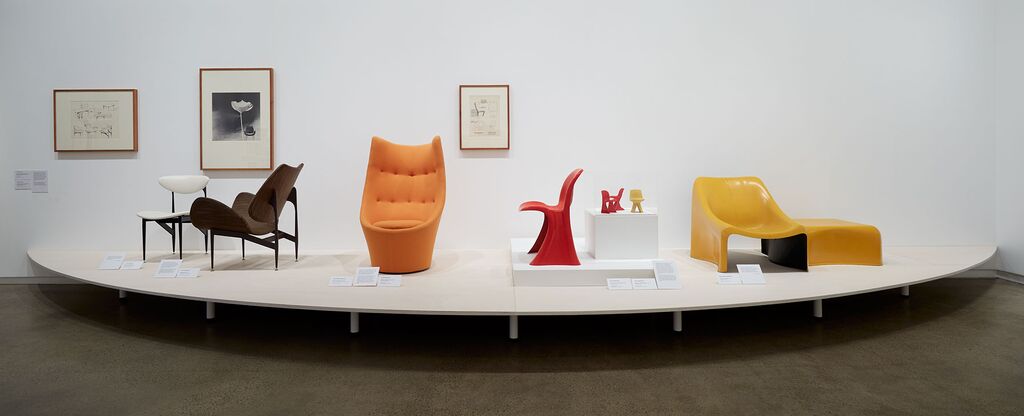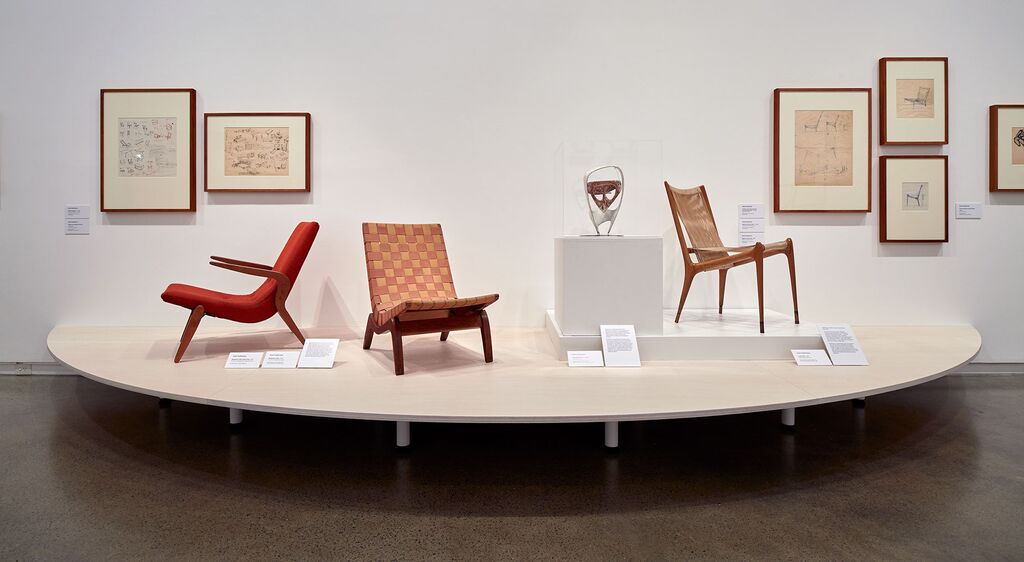Mid-twentieth century Australian furniture and lighting design was often highly derivative of the work of American designers for Knoll and Herman Miller such as Ralph Rapson and Charles Eames along with the work of the British designer, Robin Day. It can be argued that this situation was partly created by post war shortages and Australia's general tendency to look to Europe and America for inspiration but while there have been some highly accomplished practitioners in architecture - Sydney Anchor, Ken Wooley, Richard Le Plastrier, Bruce Rickard, McGlashan Everist and many others, there were few totally original thinkers in domestic product design. The best of the post war designers included Schulim Krimper, George Korody, Dario Zoureff, Roger McLay, Gordon Andrews, Kjell Grant, Fred Ward and Fred Lowen. There was also Clement Meadmore (although his furniture and lighting design output was short lived as he left for New York to become a sculptor in 1963). But arguably it was Grant and Mary Featherston, a debonaire couple from Melbourne, that regularly provided the most innovative approach to furniture design. Grant was largely a self taught designer while Mary had professional training, completing a degree in interior design in 1963. Grant's first design, the Relaxation chair from 1947, was the first of a veritable wave of products by Featherston through the 1950's including the highly successful Contour range. But it was together when they formed a design studio in 1965 that they began to create highly original concepts in all manner of materials.
Photographs by Christian Capurro.
It is this thirst for exploring new methods and ideas that immediately comes across in the exhibition Design For Life: Grant & Mary Featherston, currently showing at the Heide Museum of Modern Art just outside of Melbourne. The exhibition curated by Kirsty Grant and Denise Whitehouse is simple in layout, with little in the way of high impact visuals or sets. Instead it is the objects themselves, mounted on low white plinths that clearly express Grant and Mary Featherston's depth of skill and breadth of ideas. With original examples of virtually every one of their furniture designs, many on loan from the National Gallery of Victoria, the ability to discover nearly forty years of Featherston design in one space is a rare joy.
Grant Featherston was born in Geelong, Victoria in 1922. He was largely a self-taught designer, working on lighting and glass panels before serving in the army for the duration of World War II. After the war he married Claire Skinner and set about making a business out of designing and producing jewellery and buttons for the couture market. The success of this venture helped him fund his first furniture design, the Relaxation chair, in 1947 and with the help of Robin Boyd in the Small Homes Section of The Age it gained a substantial amount of attention. It wasn't until 1951 however, when he produced the first of his famous plywood shell Contour chairs that his design career really started to take off. The Contour range became so successful that he was able to create a number of variations in this general style throughout the 50's. The Featherston Contract Interiors furniture showroom opened in 1956, and a year later he became a consultant to Aristoc Industries, a position he continued to hold for 13 years, designing many innovative products for the company including the Scape and Expo '67 chairs shown at the top of this post.
Mary Featherston (formerly Mary Currey) was born in Surrey in England but immigrated to Australia in 1953. She trained in Interior Design at RMIT and in 1965 formed a personal and professional partnership with Grant Featherston. This partnership lasted until Grant's death in 1995. Over this thirty year period the couple worked on a wide range of artistic projects including furniture, exhibition and graphic design. Major projects included the fit-out of the National Gallery of Victoria (1966-68), a number of furniture ranges for Aristoc Industries and Uniroyal/Bridgestone but there were many more projects than these. For a much greater insight into the fascinating lives and careers of the Featherston's, take a look at an excellent article by Denise Whitehouse here.
"The essential fundamental of all design is human use"
Grant & Mary Featherston
The Featherston Archive was created to catalogue the work and life of Grant and Mary Featherston and includes furniture, prototypes, objects, drawings, sketches, photographs, notes and letters. You can take a look at the Featherston Archive here. The majority of the archive is currently stored at the National Gallery of Victoria with a small number of examples available to view online. In 1996 Grant and Mary were inaugural inductees into the Design Institute of Australia Hall of Fame. Mary Featherston continues to promote the work of the Featherston studio, is a Fellow of the Design Institute of Australia, a Board Ambassador with the Robin Boyd Foundation, and a Senior Fellow at the University of Melbourne. Many of the chairs by Grant and Mary Featherston are back in production by Gordon Mather Industries and available through Grazia & Co. Vintage examples of Featherston designs continue to increase in value with early chairs fetching tens of thousands of dollars - often regardless of poor condition. The desire for the authentic and the rare is extremely strong and Featherston oeuvre is considered one of the most collectable in post war Australian design.
One of the benefits of visiting the Featherston exhibition at Heide is the abilty to experience the radically different homes of famous Melbourne collectors John and Sunday Reed. Heide I was a traditional weatherboard cottage purchased in 1934 by the Reeds. It remained their family home until 1963 when they requested David McGlashan of McGlashan Everist to design a contemporary building to house their personal art collection but also to act as their new family home. The couple are reported to have asked for a ‘gallery to be lived in’ and when it was complete they continued to live there until 1980 when they donated the house to the state as a public gallery. The Reeds (who both died in 1981) were two of Australia's most important art benefactors and champions of modern art and literature with Sidney Nolan’s Kelly series being painted in Heide I and Albert Tucker and Joy Hester living there for a time.
Right next door to Heide II is the newer zinc-clad exhibition space originally designed by Andrew Andersons from Peddle Thorp Architects and extended in 2005 by O'Connor + Houle Architecture. It is Heide III that currently houses the Featherston exhibition. Around these three buildings are fifteen acres of gardens and sculpture park. In terms of a day out if you find yourself in Melbourne it is hard to beat.
The exhibition Design for Life: Grant & Mary Featherston continues until 7th October 2018.
Address: 7 Templestowe Road Bulleen Vic 3105
Hours: Tuesday to Sunday 10-5pm
For more information contact Heide Museum of Modern Art here or call (03) 9850 1500
















